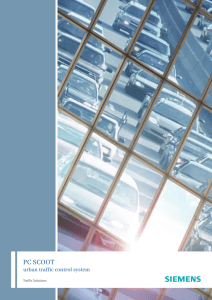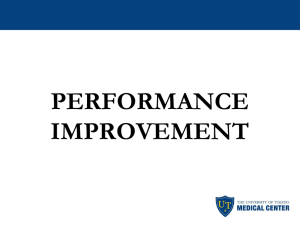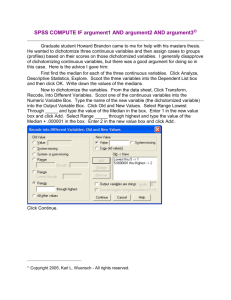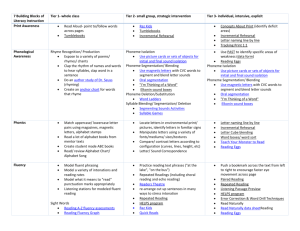The use of ANPR technology for traffic management and
advertisement
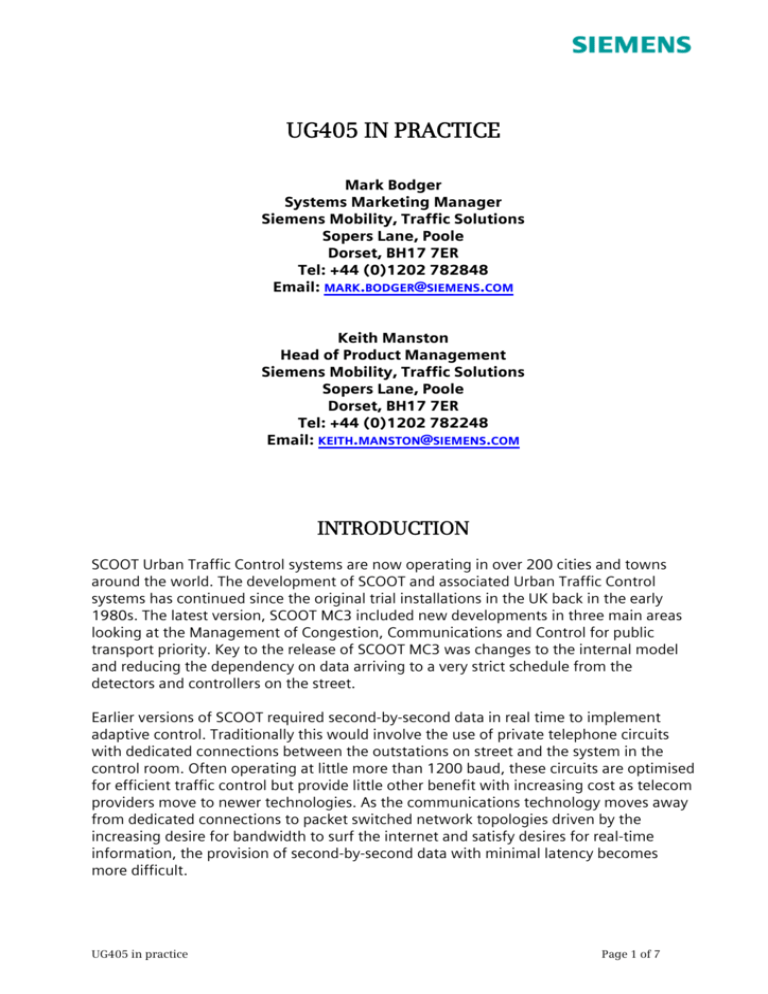
UG405 IN PRACTICE Mark Bodger Systems Marketing Manager Siemens Mobility, Traffic Solutions Sopers Lane, Poole Dorset, BH17 7ER Tel: +44 (0)1202 782848 Email: MARK.BODGER@SIEMENS.COM Keith Manston Head of Product Management Siemens Mobility, Traffic Solutions Sopers Lane, Poole Dorset, BH17 7ER Tel: +44 (0)1202 782248 Email: KEITH.MANSTON@SIEMENS.COM INTRODUCTION SCOOT Urban Traffic Control systems are now operating in over 200 cities and towns around the world. The development of SCOOT and associated Urban Traffic Control systems has continued since the original trial installations in the UK back in the early 1980s. The latest version, SCOOT MC3 included new developments in three main areas looking at the Management of Congestion, Communications and Control for public transport priority. Key to the release of SCOOT MC3 was changes to the internal model and reducing the dependency on data arriving to a very strict schedule from the detectors and controllers on the street. Earlier versions of SCOOT required second-by-second data in real time to implement adaptive control. Traditionally this would involve the use of private telephone circuits with dedicated connections between the outstations on street and the system in the control room. Often operating at little more than 1200 baud, these circuits are optimised for efficient traffic control but provide little other benefit with increasing cost as telecom providers move to newer technologies. As the communications technology moves away from dedicated connections to packet switched network topologies driven by the increasing desire for bandwidth to surf the internet and satisfy desires for real-time information, the provision of second-by-second data with minimal latency becomes more difficult. UG405 in practice Page 1 of 7 Enhancements to the core SCOOT model in MC3 now allow for small time delays in communications between the UTC software and Outstation Transmission Units. These developments allow the core SCOOT algorithm to tolerate more variation on communications latency and hence increase the options available – particularly opening up the potential use of packet based data communication systems. Up until now, these developments have had limited application without the corresponding developments in communications protocols to street devices. The advent of the UG405 development finally allows users the full benefits available within SCOOT MC3 and the potential for using a wider variety of communications links and reducing revenue by sharing infrastructure. UG405 AND SCOOT MC3 The UG405 programme was a research programme from the Department for Transport in 2004/05 which considered “Optimising Communications Networks for Traffic Management and Control”. Created as a result of the changing market for communications technology and a desire to reduce the dependency of UTC systems on dedicated leased lines, the project was a collaboration between local authorities and industry in the UK with wide experience in both communications and traffic control. Following the initial stages of the project, Siemens, Peek and TRL became involved in the project in an advisory capacity considering the requirements of the SCOOT system and also the developments which were planned at that time (MC3) Following the release of SCOOT MC3, Siemens and Peek became very much more involved with the UG405 partners, reviewing and updating a proposed amendment to the UTMC specifications to support the use of new packet-switched communications networks. This considered both the original simple-MIB developed for UTMC by Siemens and the UTC MIB developed by Peek and how these could migrate to a new consolidated protocol which included support for SCOOT MC3. After much developments work and discussions, the final version of the new UTMC UG405 MIB was included in the TS004:2008 release of the UTMC technical specifications at the conference in Leeds in December 2008. The original simple MIB transferred data on a second-by-second basis using an SNMP format in line with most other UTMC communications links. Whilst this provides equivalent performance to “traditional” UTC communications links, the stringent latency requirements limit the communications networks it can effectively operate over. Generally this simplifies to a high-bandwidth connection such as fibre or Ethernet. Outstations have also been operated successfully over ADSL but the latency sometimes UG405 in practice Page 2 of 7 causes drop-outs which have limited the effectiveness where network traffic has been high – albeit with a corresponding reduction in the revenue costs for an ADSL connection when compared to a traditional leased line. The developments within SCOOT MC3 enabled the system to remove the reliance on second-by-second communication. Small time delays and irregularities in data transmission times in communication between the UTC software and out station transmission units (OTUs) can now be accommodated, increasing the range of communication options available and in particular allows the use of some of the newer packet based data communications systems. To maintain efficient traffic control and management, SCOOT still needs to continue to receive and transmit data in a timely manner. Therefore, the aim of time stamping the data is to accommodate short delays in data transmission whilst maintaining current data in SCOOT. The objective is not to allow for frequent long delays in data transmission that would result in poor traffic control. For detector data transmitted from the OTU to the system, the aim is to maintain the delivery of second-by-second data for good traffic control. Using modern communications systems can introduce uncertainty into the data transmission process, which is allowed for in SCOOT MC3 and supported by the new UG405 protocol. Data may be: delayed, out of order, repeated or missed. However, if a complete message is received (e.g. the four bits of detector occupancy in a second), then that data will be correct. Control data transmitted to the street also includes time stamping which allows messages to be sent a short time in advance of any actual stage changes to accommodate potential delays in communication, as well as reducing the bandwidth necessary for control messages. SCOOT MC3 will operate successfully with communications that do not guarantee the time for transmission or order of data delivery and has been designed to operate efficiently with possible delays up to 4-5 seconds in communication. The integration of SCOOT MC3 into UTC system also maintains support for current communications systems, or a mixture of current and new, without the need for users to make any changes thereby providing ongoing support for legacy installations and avoiding the need for any “big-bang” changeover. The new UG405 MIB integrates time-stamping which allows communications networks to be used with less predictability in latency and network performance. The UG405 MIB with time-stamping, used in conjunction with SCOOT MC3 allows packets which arrived delayed or out of sequence to be dealt with effectively whilst maintaining the benefits associated with SCOOT adaptive control. UG405 in practice Page 3 of 7 INTEGRATION INTO THE SYSTEM In parallel with the specification development and following the release late last year, Siemens has invested heavily in the development of the Gemini UTMC outstation. This has been a complex development which offers a number of significant new features around the use of alternative communications as well the support of multiple applications within a single unit, allowing for the first time the option of MOVA or SCOOT controlled by the UTC system. The execution of major changes to any well established and reliable system must always to be managed carefully so as to ensure that unexpected problems are not introduced along with the desired new features. In the case of the Siemens UG405 development this is particularly the case as extensive changes have been necessary to both Instation and outstation components of the Siemens UTC system. To help ensure that users that who take delivery of UG405 systems can have confidence in their operation going forward extensive laboratory testing has been undertaken followed up by several ‘on-street’ trial deployments. These have been designed to test out the operation of the system using a range of different communication media and operational configurations and also, where possible, to quantify the improvement (if any) provided by the use of UG405. To facilitate the gathering of meaningful data the trials have been conducted in 3 defined steps:1. Where existing sites are operating UTMC using the current ‘simple’ MIB, gather communication statistics to act as a baseline against which the performance of the new system can be measured. 2. Install the new UTMC OTU, but retain communication using the simple MIB, to confirm that no changes in performance (either better or worse) are delivered just by changing the equipment base. 3. Switch over to using the new UG405 MIB and record the performance obtained. In any communication system there are usually communication errors and up to a certain level these will be tolerated. For UTC, where second by second communication is traditionally used, a small number of errors are accepted, although they may impact slightly on the overall performance of the system by potentially delaying a signal change on-street or the receipt of timely SCOOT detector data. Normally however these errors are transparent to the user, but are nevertheless reported so that communication quality can be assessed. Only if the number of errors becomes excessive does the system take serious action, usually to isolate the offending OTU. This does not generally happen very often so if only this measure were to be used the results obtained might be rather coarse. Consequently for the purpose of the trial data both single communication errors and instances of OTU being taken off-line have been recorded. UG405 in practice Page 4 of 7 ON-STREET TRIALS Several trial-sites have been installed to date utilising a variety of communication options as described in the table here. In addition to these other trial installations are scheduled to extend the performance validation to cover: • Combined UTMC / MOVA operation (Fibre Communication) • Operation on a 3G Network3G modem Ferndown - Dorset Site 15SC SCN J10121 Tesco Comms type SDSL (Nexcomm) - Initial trial Comms type Wireless (802.11g) – Additional trial Surrey Site Comms type J13521 A321 Marshalls Rd / Laundry Lane ADSL Internet (Westermo providing VPN) Surrey Site Comms type J13911 Marshals Rd / Tesco Leased Line Modem (TC12 replacement) Perth Site Comms type Isla Rd / Strathmore Street Fibre Perth Site Comms type Dundee Rd / Queens Bridge Fibre INITIAL RESULTS One of the most interesting and eagerly awaited set of data is for the wireless trial site in Ferndown, where a direct comparison between SDSL and Wireless linking has been undertaken. This site (Tesco) has been set up so initially it can be controlled by a direct SDSL link but also via a wireless link from an adjacent gateway site. For the first period of the trial the site was controlled with a standard UTMC OTU running the Simple MIB. Typically during this period between 30 and 50 TX errors were recorded (Figure 1), but only a small number of these were contiguous such that they resulted in ‘no reply’ errors which take the UTMC OTU off line. (Figure 2). UG405 in practice Tesco site Gateway Page 5 of 7 The new UTMC OTU was installed on the 27th July and baselined against the existing standard UTMC OTU but continuing to run using the simple MIB. As expected this resulted in no significance change in the number of TX errors experienced. However switching to the UG405 MIB on the 13th August completely eliminated all TX errors, demonstrating that, at least in this installation configuration it is far more tolerant than the Simple MIB! Figure 1 – Sum of Tx Errors Following an approximately three week running period using the UG405 MIB on SDSL the link was re-configured to use an 802.11g wireless link driven from an adjacent controller site which had been configured in conjunction with these trials. This configuration did not prove to be error free and it was decided to switch back to the simple MIB to assess its performance. Unfortunately this demonstrated again the superiority of UG405 as with the simple MIB the wireless was so error prone that Dorset required it be put back to UG405 control after only 24 hours. UG405 in practice Page 6 of 7 Figure 2 – Sum of “OTU No Reply” failures This trial continues to gather data and work is underway to see if the basic wireless performance can be further improved utilising the benefits offered in the implementation of the new UG405 protocol. CONCLUSIONS To date only limited results have been gathered from the UG405 trial, however these do show that implementation of the UG405 MIB offers significantly higher tolerance to communication errors than the simple MIB (which in turn is similar to TC12). This demonstrates the potential for effective use of alternative communications media with SCOOT MC3 whilst maintaining all the benefits traditionally available with SCOOT adaptive control. The trial continues and further data will be made available during the Siemens User Group meetings in October. UG405 in practice Page 7 of 7


